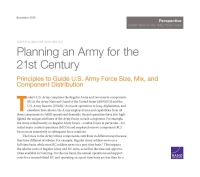by Joshua Klimas, Gian Gentile
 In U.S. defense strategic guidance over the past several decades, one of the pillars of force planning has been the requirement for a highly ready and rapidly deployable Army. As a result, this basic imperative has long been a significant driver of U.S. Army force size, mix, and component distribution.
In U.S. defense strategic guidance over the past several decades, one of the pillars of force planning has been the requirement for a highly ready and rapidly deployable Army. As a result, this basic imperative has long been a significant driver of U.S. Army force size, mix, and component distribution.
In this Perspective, the authors seek to provide criteria for an effective and efficient Army for the 21st century. They review the history of how the United States has adapted principles guiding Army force planning to meet strategic needs, examine the range of major missions that the Army must be able to perform to meet today's defense strategy, and lay out principles to help guide leaders in making contemporary force-planning decisions. Although the principles discussed may not be new, they represent principles that leaders, force planners, and others should keep in mind when considering changes or new investments in Army end strength and force structure. Furthermore, the principles reinforce the tenet that decisions on Army force size, mix, and distribution should flow from the defense needs of the present and future rather than preserve legacy decisions of the past.
No comments:
Post a Comment